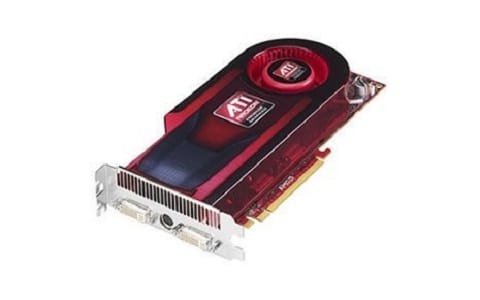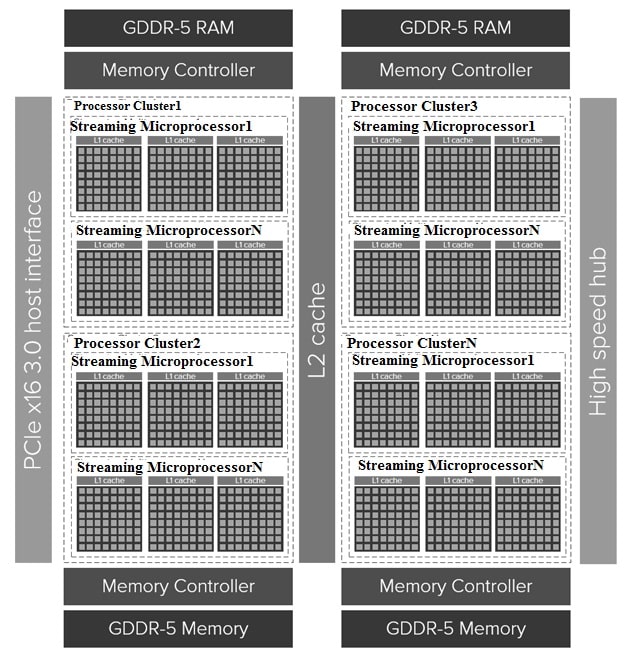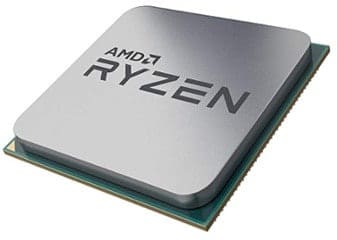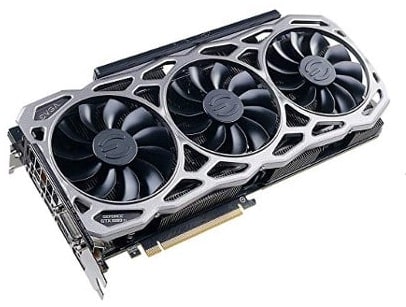The first graphics processing unit was developed in the year 1999 by NVidia known as the GeForce 256. So this type of GPU processor could process ten million polygons for each second & also had above 22 million transistors. This was a single-chip processor including integrated transform, BitBLT support, drawing, triangle setup, lighting effects, clipping & rendering engines. The Graphics processing unit plays a significant role in processing different redundant calculations from VR (virtual reality) applications to self-driving cars. Every core within the CPU functions separately on a special task, GPU cores work simply in parallel on the iterative calculations that power ML or machine learning. So, this article provides brief information on graphics processing units which are also known as GPU processors.
What is a Graphics Processing Unit?
A GPU or Graphics Processor Unit is one type of electronic processor which is programmed to render different images on the screen of a computer. This processor is mainly designed for handling and changing memory very quickly to speed up the image formation within a frame buffer, and finally, these will be shown on a TV screen or mobile screen.
A graphics processing unit is also known as a graphics processor which is a separate and single peripheral in the CPU or the motherboard. The advanced GPUs perform well and they will have a smoother motion & a higher resolution on the device.

Graphics Processing Unit
Features
The features of GPU include the following.
- A GPU handles huge amounts of data within various streams.
- These processors include a number of cores that handles at a time different threads as compared to the CPU because it has few cores only with lots of cache memory that handles only a few software threads.
- Some of the best supercomputers around the world mainly depend on GPUs for advanced scientific discoveries.
- These processors are capable of performing floating-point arithmetic & vector operations with the most recent cards to manipulate double-precision floating-point numbers.
- The execution units of GPU can’t deal efficiently with branching and they don’t support interrupts of hardware equally as CPUs do.
- As compared to the CPU, GPU depreciates fast.
How Does a Graphics Processor Work?
A graphics processing unit or GPU is a specialized processor, designed for accelerating graphics rendering. These processors are helpful in processing many pieces of data at the same time, to make them functional for video editing, machine learning & gaming applications. To render various images, it needs space to hold the data which is necessary to make the complete image, so it uses Random Access Memory or RAM to store this data. This data includes every pixel of the image, its color & its position on the display.
In order to display the image in analog form, the random access memory is connected directly to a digital-to-analog converter, so it converts the image into an analog signal so that monitor can utilize it. Some systems include the above one RAM-DAC, which can enhance performance & support using the above one monitor.
The frame rate is how well a graphics processor unit works and it is measured in FPS (frames per second). So this frame rate states how many finished images can be provided on display for each second. To evaluate this, the human eye processes approximately 25 frames for each second, but quick action games should process a minimum of 60 frames for each second to give a smooth game scroll & flow.
Graphics Processing Unit Architecture
A GPU includes several processor clusters and these clusters include multiple streaming multiprocessors denoted with SM. Each streaming multiprocessor holds a layer-1 instruction cache layer through its associated cores together. Generally, a single streaming multiprocessor accepts a dedicated layer-1 cache as well as a shared layer-2 cache before pulling information from the global GDDR-5 memory. So, the architecture of the GPU processor is acceptable for memory latency. As compared to a CPU, a graphics processor unit works with fewer & somewhat small memory cache layers. The graphics processor architecture includes different components which are discussed below.

Graphics Processing Unit Architecture
Graphics Memory Controller: The GMC or graphics memory controller also called MCU (memory controller) or MCC (memory chip controller) is a digital circuit that controls the flow of data supplied from or to the graphics memory of the CPU. GMC can be a separate chip but it can also be incorporated into a different chip like being located on a similar die or as an essential element of a processor. If a graphics memory controller exists as an integral part then it is called an Integrated Memory Controller or IMC. The GMC memory controls like VRAM, MDRAM, WRAM, DDR, HBM & GDDR.
Graphics Compute Array: The GCA or graphics compute array is also called the 3D engine used for rendering graphics within 3D. Generally, graphics compute array includes pixel shaders, unified shaders/vertex shaders, CUDA cores/ stream processors, TMUs or texture mapping units, ROPs or render output units, geometry processors, L2 cache, etc.
Bus Interface: The bus interface or BIF is the communication system used to transmit the data between the components of the GPU. This bus interface is very helpful in interfacing tiny peripheral devices like flash memory through the processor. Generally, it includes VLB, SA, PCI, PCIe & AGP.
Power Management Unit: The power management unit or PMU is a microchip or a microcontroller that simply checks & controls the power utilization of the graphics processing unit. The power management unit includes several related components to the normal computer like memory, software, CPU, firmware, etc. It is one of the few components that stay active even once the computer is turned off completely and powered through a backup battery.
The PMU coordinates different functions within a portable computer like; it monitors battery charges & connections of power, shuts downs needless parts of the system once they are left idle, controls power and sleep functions, controls power to other ICs, charges batteries once required, and control the RTC (real-time clock).
Video Processing Unit: The video processing unit or VPU is a microprocessor that uses video streams like input & executes very difficult processes on the input flow. Generally, a video processing unit is used within machine learning devices & works as an auxiliary component within those devices. VPU is responsible for encoding & decoding video. Thus, it is also known as a video encoder & decoder. VPU also performs the compression otherwise decompression of Theora, MPEG2, VP8, H.265, H.264, VC-1, VP9, etc.
Display Interface: The display interface or DIF is also known as a display controller that defines a serial bus as well as a communication protocol between the host, the image data source & the destination device. This interface simply transmits the processed information to the display and it includes HDMI audio, RAMDACs, DP audio, video underlay, PHY & EDID.
The architecture of GPU is very simple as compared to CPU. This processor architecture has much more cores as compared to a CPU to attain parallel data processing through high tolerate latency. So, such a type of processor is known as GPGPU or general-purpose GPU which is used to speed up computational workloads in current HPC (high-performance computing).
Graphics Processor Types
The graphics processing units are two types integrated GPU and Discrete GPU which are discussed below.
Integrated GPU:
The integrated GPU is a computer where this processor is built on a similar chip as the CPU. Being built along with the CPU simply provides many benefits like being small in size, energy efficiency, and not expensive as compared to the opposed discrete GPU. These types of GPUs use the system RAM instead of having their own RAM similar to discrete GPUs. The benefit of This GPU is that they don’t consume as much power & generate heat as discrete GPUs but they also less cost to acquire.

Integrated GPU
Discrete GPU:
A dedicated graphics card like a discrete GPU is totally separate from the CPU. The graphics card encapsulates the graphics processor to separately process instructions & elements from the CPU. This graphic card has its own form of VRAM or video RAM which provides the discrete GPU fast access to image data. The main drawback of this dedicated graphics card is; it generates more heat. In a computer, the GPU is frequently the hottest running device, which needs a strong power supply.

Discrete GPU
Difference B/W Graphics Processor Vs Graphics Card
The difference between a graphics processor and a graphics card includes the following.
|
Graphics Processor |
Graphics Card |
| The graphics processor is a chip within a graphics card. | A Graphics card is an expansion card within the computer. |
| The Graphics processor is known as GPU. | A Graphics card is also called a video card, display card, graphics adapter, and display adapter. |
| The main function of GPU is to perform the actual images & graphics processing. | The main function of a graphics card is to that produce images to display on the o/p device. |
| Graphic processors are silicon layered with palladium, tantalum transistors & capacitors for superior storage on a little chip. The materials mainly utilized for GPU & RAM cards are designed with different materials like boron, copper, tungsten & cobalt. | A graphics card is available in a printed circuit board form to be placed into an expansion slot. Others may have dedicated enclosures, and they are connected to the computer via a docking station or a cable. These are known as external GPUs (eGPUs). |
| The GPU is used in different applications like graphics, video rendering, gaming, creative production & AI (artificial intelligence). | Graphics card is used in 3D animation, video gaming & video editing. |
Advantages
The advantages of graphics processing units include the following.
- The graphic processing unit is used in video editing, gaming & machine learning applications.
- These are integrated into the CPU of the computer.
- These are capable of graphics rendering in both 2D & 3D.
- A GPU includes a number of cores that allows it to execute particularly parallel calculations like multiplications of the matrix.
- These processors can perform parallel operations.
- The manufacturers of these processors release the most recent drivers occasionally.
- These are used wherever an image is required to be processed.
- These processors are available with their memory which performs different graphics-associated tasks & processing.
- GPUs have high throughput.
- These processors are excellent for parallel processing.
- GPUs need extra software for changing the functions of the CPU to the GPU for parallel execution.
- These processors can provide massive acceleration for particular tasks such as big data analytics, deep learning, genomic sequencing & many more.
The disadvantages of graphics processing units include the following.
- These processors require lots of regularity, data reuse, and data parallelism.
- As compared to CPUs. GPUs are very harder to program & tune.
- GPUs perform a single task at a massive scale, however, they cannot execute general-purpose computing tasks.
- Individual GPUs processors are at present very expensive as compared to CPUs.
- Special large-scale GPUs can cost hundreds to thousands of dollars.
- Graphic processing units execute only some kinds of code.
- GPUs can perform a single task at a huge scale, however, they cannot perform normal computing tasks.
- a GPU processor struggles with processing tasks that are not structured well. So, they cannot process sequential operations, branching logic, or other difficult programming patterns efficiently.
Applications
The applications of graphics processing units include the following.
- A graphics processing unit renders graphics, animations, images, and video by simply performing quick mathematical calculations.
- These processors are mainly used for both personal & professional computing.
- GPU processors work by using parallel processing methods, where several processors handle separate elements of the same task.
- These are used in PC gaming.
- These processors are also used by Developers to speed up workloads in artificial intelligence areas.
- GPUs are suitable for parallel processing & are the ideal options for AI model training in most cases.
- These processors were used by enterprises because most AI applications need parallel processing of various calculations.
- GPU processors provide the raw computational power necessary for processing unstructured & mainly identical data.
- GPU processors have moved from PCs to workstations and data centers.
Know more about Super Capacitor.
Thus, this is all about an overview of the graphics processing unit or GPU processor. This processor is mainly designed to operate & change memory to speed up the creation of images within a frame buffer intended for output to a display device. These processors are used in mobile phones, embedded systems, personal computers, game consoles & workstations. Here is a question for you, what is CPU?